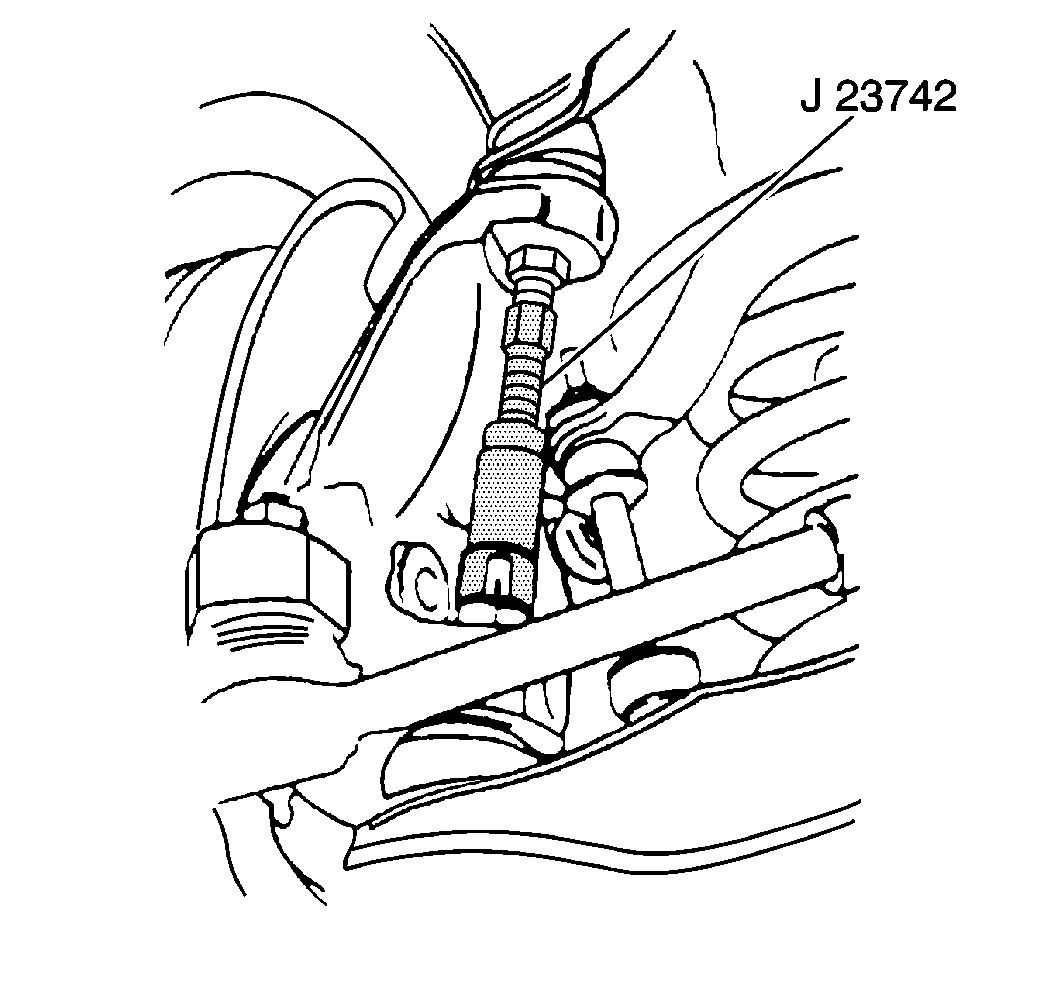Removal Procedure
Tools Required
J 23742 Ball Joint Separator
- Raise the vehicle. Refer to Lifting and Jacking the Vehicle in General Information.
- Remove the tire and wheel assembly. Refer to Wheel Removal in Tires and Wheels.
- Remove the brake caliper. Refer to Brake Caliper Replacement in Disc Brakes.
- Remove the rotor/hub assembly. Refer to Front Wheel Hub, Bearing, and Seal Replacement .
- Remove the splash shield.
- Disconnect the tie rod end from the steering knuckle. Refer to Tie Rod Replacement in Steering Linkage.
- Remove the knuckle gasket only if the knuckle is being repaired or replaced.
- Remove the cotter pins and the nuts from the upper ball joint and the lower ball joint.
- Remove the upper ball joint stud from the knuckle.
- Disconnect the steering knuckle from the lower ball joint.
- Clean the steering knuckle with solvent, then air dry.
- Inspect the steering knuckle tapered holes that attach to the ball joints and the tie rod end. Replace the steering knuckle if any of the three holes are out-of-round, deformed, or damaged.
- Inspect the spindle for wear or damage.
Important: Do not place safety stands under the lower control arms because the vehicle may slip off of the stands during steering knuckle removal.
Notice: Support the caliper with a piece of wire to prevent damage to the brake line.




Caution: Floor jack must remain under the lower control arm during removal and installation to retain the lower control arm in position. Failure to do so could result in personal injury.
| 9.1. | Position a floor jack under the lower control arm near the spring seat. Raise the jack until the jack just supports the lower control arm. |
| 9.2. | Use the J 23742 in order to break the upper ball joint free of the steering knuckle. |
| 9.3. | Raise the upper control arm in order to disengage the upper ball joint from the knuckle. |

| 10.1. | Use the J 23742 in order to break the lower ball joint free from the steering knuckle. |
| 10.2. | Lift the steering knuckle off of the lower ball joint. |
Installation Procedure
- Connect the steering knuckle to the lower ball joint. Press the steering knuckle onto the lower ball joint until the ball joint is fully seated.
- Connect the steering knuckle to the upper ball joint. Lower the upper control arm in order to seat the upper ball joint into the steering knuckle.
- Install the ball joint nuts.
- Install new cotter pins. Tighten the ball joint nuts up to an additional 1/6 amount to insert the cotter pin through the nuts in the upper and lower ball joints. Bend the cotter pin flat against the nut.
- Remove the floor jack.
- Install the knuckle gasket.
- Connect the tie rod end to the steering knuckle. Refer to Tie Rod Replacement in Steering Linkage.
- Install the splash shield and the bolts.
- Install the rotor/hub assembly. Refer to Front Wheel Hub, Bearing, and Seal Replacement .
- Install the brake caliper. Refer to Brake Caliper Replacement in Disc Brakes.
- Adjust the wheel bearings. Refer to Wheel Bearing Adjustment .
- Install the tire and wheel assembly. Refer to Wheel Installation in Tires and Wheels.
- Lower the vehicle.
- Check the front wheel alignment. Refer to Wheel Alignment Specifications in Wheel Alignment.

Notice: Use the correct fastener in the correct location. Replacement fasteners must be the correct part number for that application. Fasteners requiring replacement or fasteners requiring the use of thread locking compound or sealant are identified in the service procedure. Do not use paints, lubricants, or corrosion inhibitors on fasteners or fastener joint surfaces unless specified. These coatings affect fastener torque and joint clamping force and may damage the fastener. Use the correct tightening sequence and specifications when installing fasteners in order to avoid damage to parts and systems.
Tighten
| • | Tighten the upper nut to 85 N·m (65 lb ft). |
| • | Tighten the lower nut to 125 N·m (90 lb ft). |


Tighten
Tighten the bolts to 14 N·m (124 lb in).
